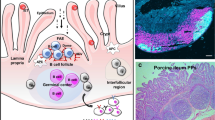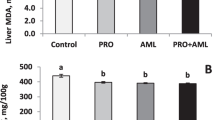Abstract
Broiler salmonellosis is a major problem for poultry industry. Here, we supplemented broiler feed with 1% of ginger stems (GS) fermented with Lactobacillus paracasei and analyzed the effects on the resistance to Salmonella gallinarum. The chickens were divided into four dietary groups. The control group (C) received the basal diet, and the other chickens received the basal diet supplemented with 0.1% w/w L. paracasei ML-7 (L group), 0.1% ginger stem powder (GS group), or 0.2% fermented ginger stem (FGS group) for 21 days. The dietary groups were further split into two subgroups: one challenged with 1 × 105 CFU/mL S. gallinarum orally administered in 1 mL of saline from days 7 and 14, and one that received 1 mL of saline without bacteria. Both uninfected and S. gallinarum-infected broilers fed with fermented GS (FGS) significantly increased body weight and feed intake, and had lower mortality compared to relative control groups. Furthermore, dietary FGS decreased cecal, Salmonella spp. counts and serum IgA and IgG levels. These results indicate that FGS prevented S. gallinarum colonization and promoted weight gain in broilers, suggesting that FGS supplementation can be effectively used as a replacement of antibiotic growth promoters to prevent Salmonella infection.
Similar content being viewed by others
References
Moghaddasi, M. S. and H. H. Kashani (2012) Ginger (Zingiber officinale): A review. J. Med. Plants Res. 6: 4255–4258.
Kim, S. H., S. Y. Park, D. J. Yu, J. C. Na, C. H. Choi, Y. Y. Park, S. J. Lee, and K. S. Ryu (2000) Effects of supplemental Lactobacillus spp. on performance and cecum microflora in broiler. Kor. J. Poult. Sci. 27: 37–41.
Nurmi, E. and M. Rantala (1973) New aspects of Salmonella infection in broiler production. Nature 241: 210–211.
Sheo, H. J. (1999) The antibacterial action of garlic, onion, ginger and red pepper juice. J. Kor. Soc. Food Sci. Nutr. 28: 94–99.
Kim, A., Y. J. Lee, M. S. Kang, S. I. Kwag, and J. K. Cho (2007) Dissemination and tracking of Salmonella spp. in integrated broiler operation. J. Vet. Sci. 8: 155–161.
Ghadban, G. S. (2002) Probiotics in broiler production–a review. Arch. Geflugelkd. 66: 49–58.
Irianto, A. and B. Austin (2002) Use of probiotics to control furunculosis in rainbow trout, Oncorhynchus mykiss (Walbaum). J. Fish. Dis. 25: 333–342.
Lee, H. R., J. H. Lee, C. S. Park, K. R. Ra, J. S. Ha, M. H. Cha, S. N. Kim, Y. Choi, J. Hwang, and J. S. Nam (2014) Physicochemical properties and antioxidant capacities of different parts of ginger (Zingiber officinale Roscoe). J. Kor. Soc. Food Sci. Nutr. 43: 1369–1379.
Kim, S. H., J. H. Son, and S. H. Lee (2009) Inhibitory effects of water extract of Lindera obtusiloba on the mast cell-mediated allergic inflammation. Kor. J. Pharmacogn. 40: 233–237.
Chun, Y. G. and H. Y. Chung (2011) Quality properties of fermented gingers. Kor. J. Food Sci. Technol. 43: 249–254.
Hwang, K. A., S. R. Shin, and K. S. Kim (2005) Changes on the flavor components in the leaf teas of Lindera obtusiloba BL. by processing methods. Kor. J. Food Preserv. 12: 68–74.
Najafi, S. and K. Taherpour (2014) Effects of dietary ginger (Zingiber Ofjicinale), Cinnamon (Cinnamomum), synbiotic and antibiotic supplementation on performance of broilers. J. Anim. Sci. Adv. 4: 658–667.
Mountzouris, K. C., P. Tsirtsikos, E. Kalamara, S. Nitsch, G. Schatzmayr, and K. Fegeros (2007) Evaluation of the efficacy of a probiotic containing Lactobacillus, Bifidobacterium, Enterococcus, and Pediococcus strains in promoting broiler performance and modulating cecal microflora composition and metabolic activities. Poult. Sci. 86: 309–317.
Sleigh, J. D. and C. T. Morag (1994) Medical Bacteriology. 4th ed., Longman Group, UK.
Patterson, J. A. and K. M. Burkholder (2003) Application of prebiotics and probiotics in poultry production. Poult. Sci. 82: 627–631.
Tamura, Z. (1983) Nutriology of bifidobacteria. Bifidobacteria Microflora. 2: 3–16.
Author information
Authors and Affiliations
Corresponding author
Additional information
These two authors have contributed equally to this work.
Rights and permissions
About this article
Cite this article
Park, KT., Oh, M., Sim, I. et al. Effects of Lactobacillus-fermented ginger stem on Salmonella-infected broiler chicks. Biotechnol Bioproc E 21, 331–336 (2016). https://doi.org/10.1007/s12257-015-0778-5
Received:
Revised:
Accepted:
Published:
Issue Date:
DOI: https://doi.org/10.1007/s12257-015-0778-5




